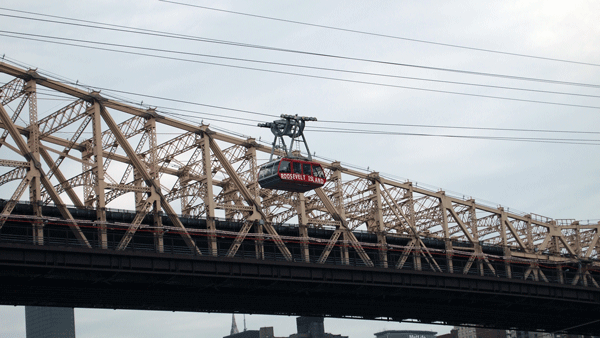
Conceptual rendering. Image from EastRiverSkyway.com
Brooklyn residents received some grim news this week as the governor announced plans to start repairs on the city’s L Train tunnels in late 2017. Officials estimate repairs taking anywhere from 1-3 years to complete. With this disruption, upwards of 300,000 -350,000 daily riders may be affected.
While this is terrible news for residents, this unexpectedly presents a massive opportunity for Cable Propelled Transit (CPT) to showcase its technological capabilities. Of course, a single urban gondola line by itself will not completely solve this transport problem.
However, the construction of any fixed link aerial transit system(s) can offer some degree of transport relief in comparison if nothing was done.

Roosevelt Island Tramway. Image by Nicholas Chu.
PAST PRECEDENCE: ROOSEVELT ISLAND TRAMWAY
As farfetched as urban gondolas might still sound to some, there is in fact considerable evidence to suggest that CPT can build network resilience and offer reliable cross-river transport service. And for those (dis)believers, they need not to look any further than in their own city to the Roosevelt Island Tramway (RIT).
Since it’s commissioning in 1976, the RIT has had a colourful history. It was designed by visionaries from Lev Zetlin Associates who studied three separate transport systems (elevator, ferry and aerial tram) before cable technology was chosen. The tram was initially installed as a temporary transit line to provide instant transport connectivity prior to a subway stop on the island. However, heavy rail didn’t arrive until 1989 and by that time, the RIT had already become an icon of Roosevelt Island.
Before it was modernized in 2010 in just 9 months, the tram provided 2 million annual riders with 34 years of reliable service. While the tram suffered a few stoppages in the mid 2000’s, this was still impressive considering the system was only designed to operate for 17 years.
INSTANTANEOUS TRANSPORT RELIEF
Unlike many mass transit technologies, we know from precedence that CPT systems can be built quickly and economically. As demonstrated by simple, cross-river city cable cars found in London and Koblenz, urban ropeways can be constructed in ~1 year.
In fact, the 1km Emirates Air Line, while ostensibly not built for the Olympics, was constructed in just 10 months time and was able open ahead of the Games’ opening cereomny. Moreover, even mega cable car projects such as the 4.4km Peak 2 Peak in Whistler took just 19 months.
Assuming decision-makers can expedite the development process for an urban cable car, a system(s) could theoretically be built and operational before the tunnels reopen.
BROOKLYN TO MANHATTAN CABLE CAR
Perhaps not surprisingly, other visionary city builders in New York have already proposed urban gondolas for improving transport between Manhattan and Brooklyn. Most recently, Daniel Levy from CityRealty, publicized his concept of the East River Skyway.
While the RIT was built to anticipate a subway opening, a theoretical “Brooklyn to Manhattan Cable Car” could be built to offer relief from a subway closure. These situations are not exactly the same, but it’s somewhat unreal to see how unbelievably comparable they are.
Who knows what kind of solutions the city comes up with, but if you ask us, it’d be somewhat irresponsible if officials didn’t once again seriously explore the feasibility of CPT.
Full Disclosure: Creative Urban Projects Inc. was retained by CityRealty as advisors on the East River Skyway Project.

1 Comment
Great idea